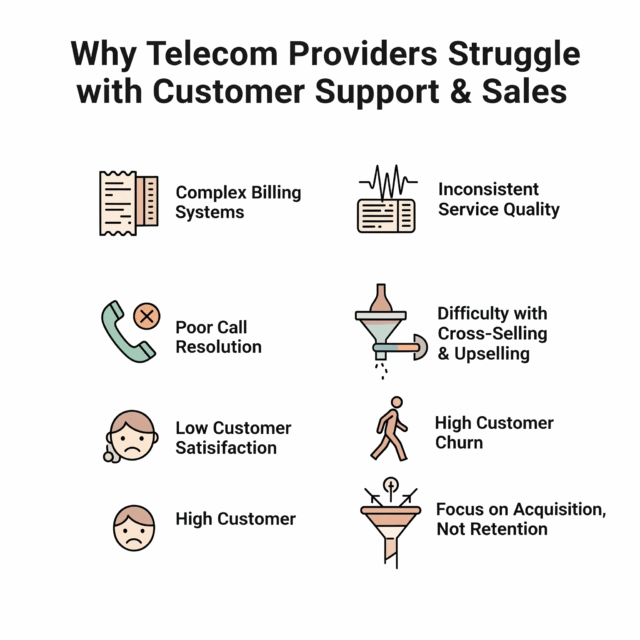In a hyper connected world you had expected telecom providers to be the benchmark for seamless communication. But ironically many telecom companies face deep rooted problems in their customer support and sales departments.
From unanswered calls to inconsistent follow ups the daily workflow for support and sales teams is far from smooth and the impact goes beyond just internal stress. It directly affects customer satisfaction loyalty and revenue.
Let’s break down what is really going wrong and what kind of systems are required to fix it.
The Reality on the Ground: Daily Frustrations of Support & Sales Teams
Whether it’s a local telecom vendor or a large scale service provider the frontlines customer support and sales face similar recurring issues:
1. Missed Calls, Missed Opportunities
Every missed call in telecom is not just a call, it’s a potential lead to a complaint waiting to be resolved or a customer about to switch providers. Sales teams lose warm leads simply because no one tracked the first call. Support teams often discover issues after a customer posts a public complaint.
In such a fast moving industry call tracking should be a default not a luxury.
2. Agents Sound Repetitive and Robotic
When support agents don’t have proper call context or access to past conversations they end up asking the same questions repeatedly. Customers grow impatient. Sales reps forget past discussions and lose trust.
The result? Conversations feel robotic and disconnected from actual user experience.
3. No Visibility into Who Handled What
When there’s no clarity on who picked up a call or replied to a query, teams end up blaming each other. There’s no timeline of communication, no caller history and no real way to measure response quality or turnaround time.
For a company built around communication this kind of internal miscommunication is ironic and costly.
4. Delayed Follow-ups and Lost Leads
Sales is all about timing. If a follow up gets delayed by a few hours or the lead is never assigned properly, chances are the customer has already signed up with someone else. In telecom, switching providers is as easy as clicking a few buttons so delays are unforgiving.
5. Too Many Tools, None in Sync
Support teams use one CRM. Sales uses Excel sheets. A separate system tracks calls. Another handles WhatsApp. But none of them talk to each other. This fragmentation leads to half baked insights and wasted hours.
The telecom business runs 24×7 but most teams still function like 9 to 5 setups with manual data entries.
Why This Is Not Just a Team Problem It’s a System Problem
It’s easy to blame individuals for missed follow ups or poor call handling. But often, the real issue is lack of centralized visibility, automation and intelligent routing.
Here’s what a telecom provider really needs in their communication workflow:
- A way to track every incoming and outgoing call
- A central system that logs conversations with time stamps and agent notes
- Automatic routing of inquiries to the right teams or departments
- Contextual insights before the call is answered (like CRM pop ups or IVR based routing)
- Real-time dashboards to see call volumes, waiting times, agent performance
- Easy access to chat and call history for faster more personalized responses
And yes all this needs to happen without switching between five different tools.
Customers Want Fast, Human and Accurate Support
Think about the end-user: someone whose internet stopped working during a video call. Or a business client waiting for number portability. Or a first time customer comparing SIM plans.
They don’t want to hear “Please hold, let me check.” They want fast answers, correct information and zero repetition.
Sales prospects expect similar treatment. If they showed interest once they expect your team to remember. If they’re confused about a plan they want human help not automated confusion.
Without intelligent systems your teams can’t offer the clarity and speed modern telecom buyers expect.
How Smart Routing and Automation Make the Difference
Let’s say someone calls to inquire about a business plan for 50 employees. With an outdated system:
- The call may go to the wrong agent
- The caller may wait too long
- No one follows up in time
- The lead disappears
With intelligent call routing (like IVR based systems):
- The caller selects the right department from the start
- The system shows the caller’s past interaction (if any)
- An available sales agent is notified instantly
- Follow ups are automated through reminders or email triggers
All of this boosts efficiency, trust and closure rates without increasing team size.
The B2B Angle: Why This Is Critical for Business Clients
Telecom providers don’t just serve individuals. They support small businesses, large enterprises, customer support centers and global brands. These clients expect a professional, timely and consistent support experience.
Failing here does not just lose a customer it can ruin long term business relationships.
Conclusion: The Way Forward
If you’re in the telecom industry, the problem is not that your support and sales teams are not trying. The problem is they do not have the right tools to stay fast, accountable and informed.
The world has moved on from sticky notes and spreadsheet CRMs. Smart telecom providers are now adopting intelligent systems that offer:
- Better call routing
- Clear conversation history
- Live dashboards
- Team accountability without micromanagement
In the end customers don’t remember how hard your team worked. They remember how smooth the interaction felt.
It’s time telecom providers focused on fixing the backend chaos, not just adding more staff or switching CRMs.







